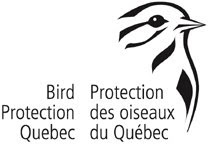St. Catherine: In the Bay in front of the locks, there were 200-300 Brant sitting on the rocks.
dans la baie face aux écluses, il y avait 200-300 Bernaches cravants posées sur les roches. - Pierre Bannon
-----------------------------------------------------------------------------------------
Granby, Centre d'Interprétation de la Nature du Lac Boivin: American White Pelican was there around 10:30 this morning, he came to feed in the algae near the boardwalk. At the tower near the center, 2 Horned Grebes with the Mallards.
Le Pélican d'Amérique était toujours au Lac Boivin ce matin vers 10:30, il est venu s'alimenter dans les algues près de la passerelle. À la tour près du centre, 2 Grèbes esclavons avec des colverts. - Roger Roy
--------------------------------------------------------------------------
Good sightings today today in the Lower St. Lawrence in the company my good friend Claude Deschênes. A great show of shorebirds this afternoon west of (quai de) Kamouraska dock. A total of 9 species totaling over 350 individuals: - Black-bellied Plover (75), - Semipalmated Plover (40) Including one independent. Juvenile well marked and tagged, on the flats east of the village.- PHOTOS - Greater yellowlegs (3), Ruddy Turnstone (2), Red Knot (45), Sanderling (12), Semipalmated Sandpiper (2), White-rumped Sandpiper (25), Dunlin (150)
Also our first Bohemian waxwings (25) and the first Snow bunting for the season. Some Lapland Longspur (3) and Red-throated Loon (2) beside the River Ouelle. At the dock we missed the King Eider and Jean-Francois!?!? by just minutes ...
To return to this well "decorated", Semipalmated Plover: The birds breast was well marked with a yellow-orange dye. Right leg; white band like "flag" measuring about 3 cm and a red ring, the both located in the tibia. Also a small aluminum ring at the foot of the bird. Left leg; combination of rings at tibia pale blue top and orange bottom. If someone would have Information about this project marking Semipalmated plovers, we would like to know the provenance of the capture of this young specimen year. Thank you in advance!
Bonne journée d’observation aujourd’hui dans le Bas-St-Laurent en compagnie de mon bon ami Claude Deschênes. Superbe spectacle de limicoles en fin d’après-midi à l’Ouest du quai de Kamouraska. Un total de 9 espèces totalisant plus de 350 individus: - Pluvier argenté (75), - Pluvier semipalmé (40) Dont un ind. juvénile bien marqué et étiqueté sur les battures à l’est du village. PHOTOS - Grand Chevalier (3), Tournepierre à collier (2), Bécasseau maubèche (45), Bécasseau sanderling (12), Bécasseau semipalmé (2), Bécasseau à croupion blanc (25), Bécasseau variable (150)
Également nos 1er Jaseurs boréaux (25) ainsi qu’un tout 1er Bruant des neiges pour la saison. Quelques Plectrophane lapon (3) et Plongeon catmarin (2) du côté de Rivière-Ouelle. Au quai nous avons manqué l’Eider à tête rise ainsi que Jean-François!?!? par quelques minutes à peine…
Pour revenir à ce Pluvier semipalmé bien « décoré », voilà : Poitrine de l’oiseau bien marquée d’une teinture jaune-orangée. Patte droite; etiquette blanche genre « flag » mesurant environ 3 cm ainsi qu’une bague rouge, les deux situées au niveau du tibia. Également une petite bague en aluminium au niveau du pied de l’oiseau. Patte gauche; combinaison de bagues au tibia de couleur bleu pâle en haut et orange en bas. Si quelqu’un aurait de l’information au sujet ce projet de marquage de pluviers semipalmés, nous aimerions bien savoir la provenance de la capture de ce jeune spécimen de l’année. Merci à l’avance! - Robin Gingras
--------------------------------------------------------------------------
Bassin de Chambly basin: This afternoon, I found the Canvasback duck on Chambly Basin. It was quite far off, almost across the street Georges-Pépin. It is a female or immature bird.
Yesterday afternoon, there were a bunch of diving ducks at about the same place with nine White-winged Scoters, some Black scoters, a few Bufflehead and two Red-breasted Mergansers. All females. Not seen today. At the fort, then as now, three Common mergansers and fifty Bonaparte's Gulls.
Today, in front of Napoleon Street, above the dam, there were now many Lesser Scaup, a few Greater scaup, two Common Golden-eye, a gorgeous male Wood Duck, twenty Black ducks and Mallards
Cet après-midi, j'ai retrouvé le Fuligule à dos blanc sur le Bassin de Chambly. Il était assez loin, au large, à peu près en face de la rue Georges-Pépin. C'est une femelle ou un oiseau immature.
Hier après-midi, il y avait une bande de canards plongeurs à peu près au même endroit incluant neuf Macreuses brunes, quelques Macreuses (noir) à bec jaune, quelques Petits Garrots et deux Harles huppés. Tous des individus du type femelle. Pas revus aujourd'hui. Au fort, hier comme aujourd'hui, trois Grands Harles et une cinquantaine de Mouettes de Bonaparte.
Aujourd'hui, en face de la rue Napoléon, en amont du barrage, il y avait aujourd'hui beaucoup de Petits Fuligules, quelques Fuligules milouinans, deux Garrots à oeil d'or, un superbe mâle du Canard branchu, une vingtaine de Canards noirs, des Canards colverts...Michel Bertrand
Wednesday, October 20, 2010
Subscribe to:
Post Comments (Atom)





No comments:
Post a Comment